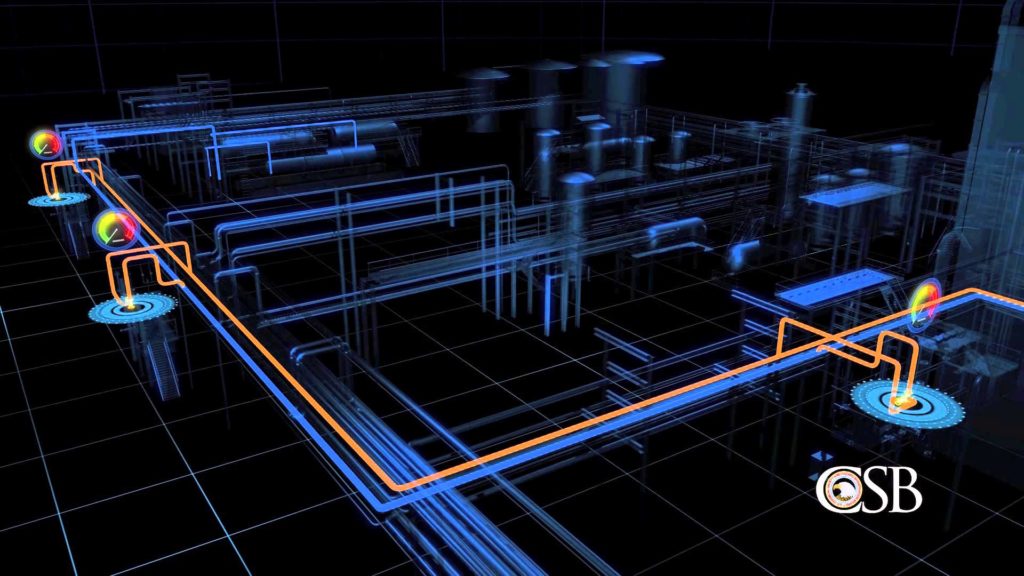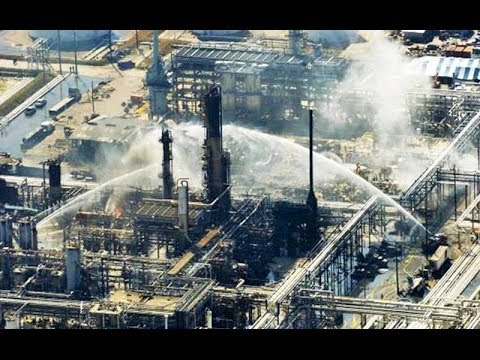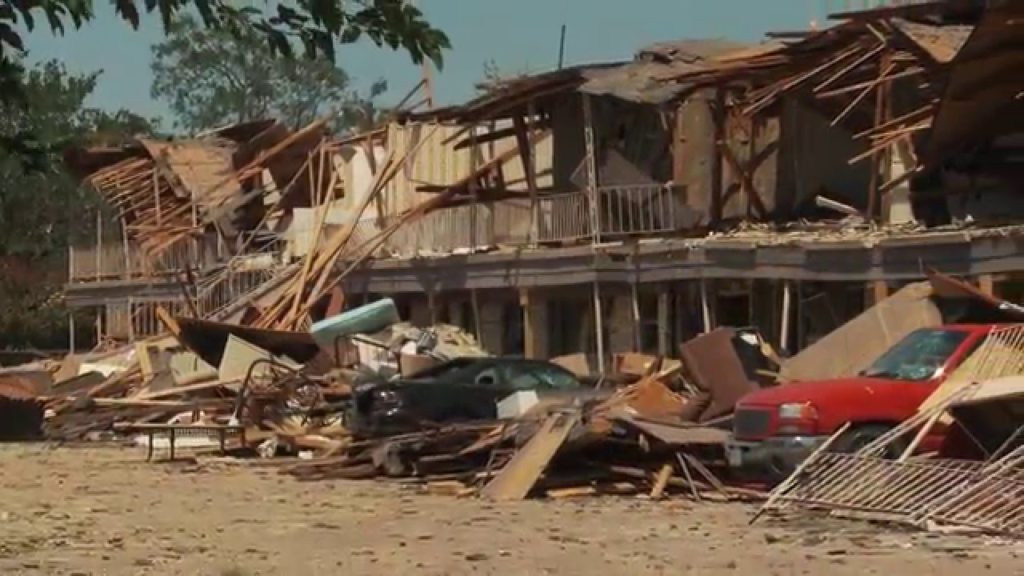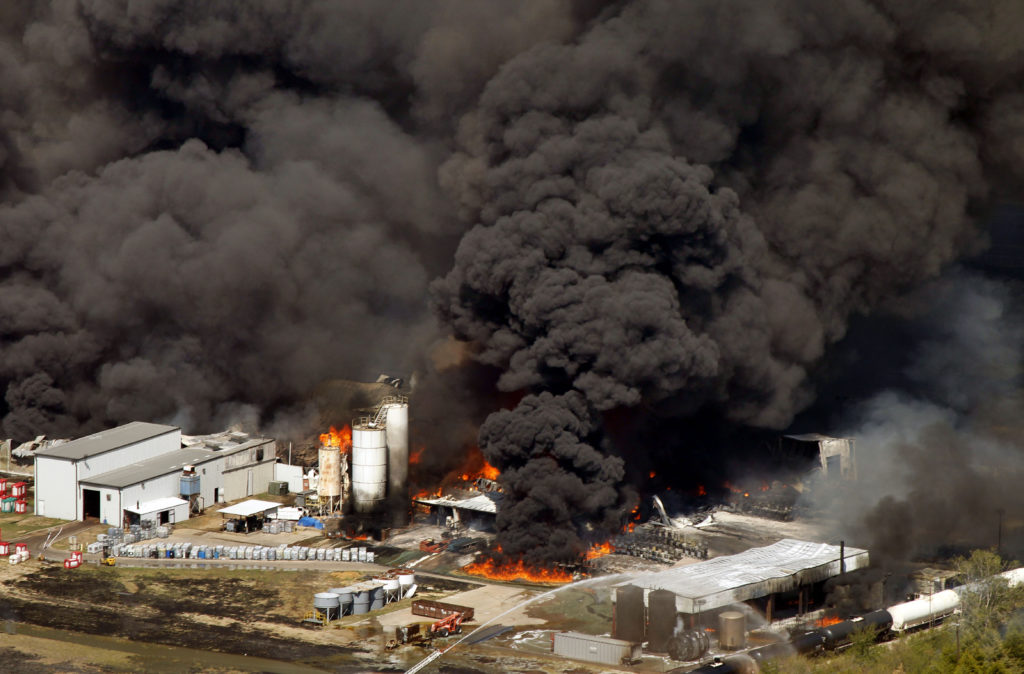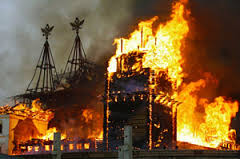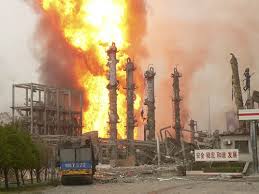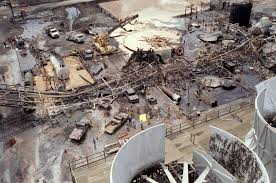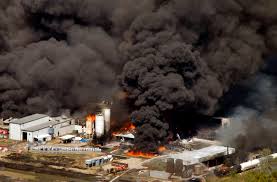Industrial accident
Industrial accidents are severe mishaps that result in injuries to people and damage to property or the environment. For example, an explosion or fire at a pyrotechnics manufacturing facility is an industrial accident, as is the accidental release of toxic chemicals to the environment when a storage tank fails. Types of industrial accidents vary from one place to the next, but most are a result of unsafe conditions and unsafe acts.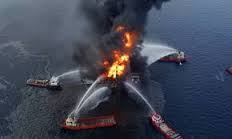
This article lists notable industrial disasters, which are disasters caused by industrial companies, either by accident, negligence or incompetence. They are a form of industrial accident where great damage, injury or loss of life are caused.
Other disasters can also be considered industrial disasters, if their causes are rooted in the products or processes of industry. For example, the Great Chicago Fire of 1871 was made more severe due to the heavy concentration of lumber industry facilities, wood houses, and fuel and other chemicals in a small area. The Convention on the Trans boundary Effects of Industrial Accidents is designed to protect people and the environment from industrial accidents.The Convention aims to prevent accidents from occurring, to reduce their frequency and severity,and to mitigate their effects. The Convention addresses primarily industrial accidents in one country that affect the population or the environment of another country. The Convention was drafted following the Seveso disaster and Sandoz disaster.
Energy industry accidents;
- October 1957: The Windscale fire, the worst nuclear accident in Great Britain’s history, released substantial amounts of radioactive contamination into the surrounding area at Windscale, Cumberland (now Sellafield, Cumbria).
- May 1962: The Centralia, Pennsylvania coal mine fire began, forcing the gradual evacuation of the Centralia borough. The fire continues to burn in the abandoned borough.
- March 1967: The Torrey Canyon supertanker was shipwrecked off the west coast of Cornwall, England, causing an environmental disaster. This was the first major oil spill at sea.
- August, 1975: The Banqiao Dam failed in the Henan Province of China due to extraordinarily heavy rains and poor construction quality of the dam, which was built during the Great Leap Forward. The flood immediately killed over 100,000 people, and another 150,000 died of subsequent epidemic diseases and famine, bringing the total death toll to around 250,000 and making it the worst technical disaster ever.
- March 16, 1978: The Amoco Cadiz, a VLCC owned by the company Amoco (now merged with BP) sank near the northwest coast of France, resulting in the spilling of 68,684,000 US gallons of crude oil (1,635,000 barrels). This is the largest oil spill from an oil tanker in history.
- March 28, 1979: Three Mile Island accident. Partial nuclear meltdown. Mechanical failures in the non-nuclear secondary system, followed by a stuck-open pilot-operated relief valve in the primary system, allowed large amounts of reactor coolant to escape. Plant operators initially failed to recognize the loss of coolant, resulting in a partial meltdown. The reactor was brought under control but not before up to 481 PBq (13 million curies) of radioactive gases were released into the atmosphere.
- June 3, 1979: Ixtoc I oil spill. The Ixtoc I exploratory oil well suffered a blowout resulting in the third-largest oil spill and the second-largest accidental spill in history.
- November 20, 1980: A Texaco oil rig drilled into a salt mine transforming Lake Peigneur, a freshwater lake before the accident, into a saltwater lake.
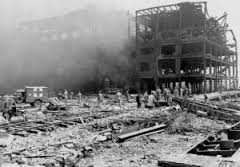
- February 15, 1982: Newfoundland, Canada. The mobile offshore oil rig Ocean Ranger was struck by a rogue wave off the coast of Newfoundland, Canada and sank with the loss of all 84 crew.
- July 23, 1984: Romeoville, Illinois, Union Oil refinery explosion killed 19 people.
- November 19, 1984: San Juanico Disaster. An explosion at a liquid petroleum gas tank farm killed hundreds and injured thousands in San Juanico, Mexico.
- April 26, 1986: Chernobyl disaster. At the Chernobyl nuclear power plant in Prypiat, Ukraine a test on reactor number four went out of control, resulting in a nuclear meltdown. The ensuing steam explosion and fire killed up to 50 people with estimates that there may be between 4,000 and several hundred thousand additional cancer deaths over time. Fallout could be detected as far away as Canada. The Chernobyl Exclusion Zone, covering portions of Belarus and Ukraine surrounding Prypiat, remains contaminated and mostly uninhabited. Prypiat itself was totally evacuated and remains as a ghost town.
- May 5, 1988: Norco, Louisiana, Shell Oil refinery explosion. Hydrocarbon gas escaped from a corroded pipe in a catalytic cracker and was ignited. Louisiana state police evacuated 2,800 residents from nearby neighborhoods. Seven workers were killed and 42 injured. The total cost arising from the Norco blast is estimated at US$706 million.
- July 6, 1988: Piper Alpha disaster. An explosion and resulting fire on a North Sea oil production platform killed 167 men. The total insured loss was about US$3.4 billion. To date it is rated as the world’s worst offshore oil disaster in terms both of lives lost and impact to industry.
- March 24, 1989: Exxon Valdez oil spill. The Exxon Valdez, an oil tanker bound for Long Beach, California, hit Prince William Sound’s Bligh Reef, dumping an estimated minimum 10.8 million US gallons (40.9 million litres, or 250,000 barrels) of crude oil into the sea. It is considered to be one of the most devastating human-caused environmental disasters ever to occur. 100,000 to as many as 250,000 seabirds died, as well as at least 2,800 sea otters, approximately 12 river otters, 300 harbor seals, 247 bald eagles, and 22 orcas, and billions of salmon and herring eggs were destroyed.Overall reductions in population have been seen in various ocean animals, including stunted growth in pink salmon populations.Sea otters and ducks also showed higher death rates in following years, partially because they ingested prey from contaminated soil and also from ingestion of oil residues on their hair/feathers due to grooming.The effects of the spill continue to be felt 20 years later.
- March 23, 2005: Texas City Refinery explosion. An explosion occurred at a BP refinery in Texas City, Texas. It is the third largest refinery in the United States and one of the largest in the world, processing 433,000 barrels of crude oil per day and accounting for three percent of that nation’s gasoline supply. Over 100 were injured, and 15 were confirmed dead, including employees of Jacobs, Fluor and BP. BP has since accepted that its employees contributed to the accident. Several level indicators failed, leading to overfilling of a knockout drum, and light hydrocarbons concentrated at ground level throughout the area. A nearby running diesel truck set off the explosion.
- December 11, 2005: Hertfordshire Oil Storage Terminal fire. A series of explosions at the Buncefield oil storage depot, described as the largest peacetime explosion in Europe, devastated the terminal and many surrounding properties. There were no fatalities. Total damages have been forecast as £750 million.
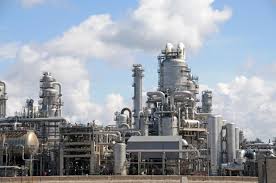
- August 17, 2009: Sayano–Shushenskaya power station accident. Seventy-five people were killed at a hydroelectric power station when a turbine failed. The failed turbine had been vibrating for a considerable time. Emergency doors to stop the incoming water took a long time to close, while a self-closing lock would have stopped the water in minutes.
- February 7, 2010: 2010 Connecticut power plant explosion. A large explosion occurred at a Kleen Energy Systems 620-megawatt, Siemens combined cycle gas- and oil- fired power plant in Middletown, Connecticut, United States. Preliminary reports attributed the cause of the explosion to a test of the plant’s energy systems.The plant was still under construction and scheduled to start supplying energy in June 2010. The number of injuries was eventually established to be 27. Five people died in the explosion.
- April 20, 2010: Deepwater Horizon oil spill in the Gulf of Mexico. Eleven oil platform workers died in an explosion and fire that resulted in a massive oil spill in the Gulf of Mexico, considered the largest offshore spill in US history.
- March 2011: Fukushima I nuclear accidents in Japan. Regarded as the largest nuclear disaster since the Chernobyl disaster, there were no direct deaths but a few of the plant’s workers were severely injured or killed by the disaster conditions resulting from the earthquake.
- October 29, 2012: Hurricane Sandy caused a ConEdison power plant to explode, causing a blackout in most of midtown Manhattan. The blue light emitted from the arc made places as far as Brooklyn glow. No person was killed or injured.
- July 6, 2013: Lac-Mégantic, Quebec Canada. Lac-Mégantic derailment. Forty-seven people were killed when there was a derailment of an oil shipment train. The oil shipment caught fire and exploded, destroying more than thirty buildings. It was the fourth-deadliest rail accident in Canadian history.
Defense industry accidents:
- December 6, 1917: Halifax, Canada. The Halifax explosion. A ship loaded with about 9000 tons of high explosives destined for France caught fire as a result of a collision in Halifax harbour, and exploded. The explosion killed about 2000 and injured about 9000.
- October 4, 1918: T. A. Gillespie Company Shell Loading Plant explosion. An ammunition plant in Sayreville, New Jersey exploded, killing approximately 100 people, destroying 300 buildings and causing $18 million in damages.
- March 1, 1924: 1924 Nixon Nitration Works disaster. A plant for processing ammonium nitrate in Edison, New Jersey exploded, killing 24 people, injuring 100 and destroying several buildings.
- July 17, 1944: Port Chicago Disaster. A munitions explosion that killed 320 people occurred at the Port Chicago Naval Magazine in Port Chicago, California.
- August 9, 1965: Little Rock AFB in Searcy, Arkansas. 53 contract workers were killed during a fire at a Titan missile silo. The cause of the fire was determined to be a welding rod damaging a hydraulic hose allowing hydraulic vapors to leak and spread throughout the silo, which were then ignited by an open flame.
- April 10, 1988: Ojhri Camp. A military storage center in Rawalpindi, Pakistan exploded, killing more than 1,300 people.
- July 11, 2011: Evangelos Florakis Naval Base explosion, Cyprus. The disaster occurred when 98 containers of gunpowder exploded; 13 people were killed, among them the captain of the base, three commanders, twin brothers who were serving there as marines, and six firefighters, 62 people injured and knocked out the island’s power station for days.
Manufacturing industry accidents:
- January 10, 1860: Pemberton Mill was a large factory in Lawrence, Massachusetts that collapsed without warning. An estimated 145 workers were killed and 166 injured.
- March 20, 1905: Grover Shoe Factory disaster. A boiler explosion, building collapse and fire killed 58 people and injured 150 in Brockton, Massachusetts.
- March 25, 1911: Triangle Shirtwaist Factory fire in New York City. This was a major industrial disaster in the US, causing the death of more than 100 garment workers who either died in the fire or jumped to their deaths. The fire led to legislation requiring improved factory safety standards and helped spur the growth of the International Ladies’ Garment Workers’ Union, which fought for better working conditions for sweatshop workers in that industry.
- May 27, 1983: Benton fireworks disaster. An explosion at an illegal fireworks operation on a farm near Benton, Tennessee killed eleven, injured one, and inflicted damage within a radius of several miles.
- November 23, 1984 MESIT factory collapse. A part of a factory in Uherské Hradiště, Czechoslovakia collapsed, killing 18 workers and injuring 43. The accident was kept secret by the communist regime, however, the news broke the iron curtain and made it to the western media.
- May 4, 1988: PEPCON disaster, Henderson, Nevada. A massive fire and explosions at a chemical plant killed two people and injured over 300.
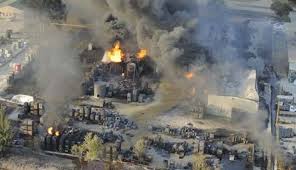
- May 10, 1993: Kader Toy Factory fire. A fire started in a poorly built factory in Thailand. Exit doors were locked and the stairwell collapsed. 188 workers were killed, mostly young women.
- May 13, 2000: Enschede fireworks disaster. A fire and explosion at a fireworks depot in Enschede, Netherlands resulted in 22 deaths and another 947 were injured. About 1,500 homes were damaged or destroyed. The damage was estimated to be over US$300 million in insured losses.
- November 3, 2004: Seest fireworks disaster. N. P. Johnsens Fyrværkerifabrik fireworks factory exploded in Seest, a suburb of Kolding, Denmark. One firefighter died; seven from the rescue team as well as 17 locals were injured. In total 2,107 buildings were damaged by the explosion, with the cost of the damage estimated at €100 million.
- April 18, 2007: Qinghe Special Steel Corporation disaster. A ladle holding molten steel separated from the overhead iron rail, fell, tipped, and killed 32 workers, injuring another 6.
- February 1, 2008: Istanbul fireworks explosion. An unlicensed fireworks factory exploded accidentally, leaving by some reports at least 22 people dead and at least 100 injured.
- September 11, 2012: Karachi, Pakistan, 289 people died in a fire at the Ali Enterprises garment factory, which made ready-to-wear clothing for Western export.
- November 24, 2012: Dhaka Tasreen Fashions fire. A seven-story factory fire outside of Dhaka, the capital of Bangladesh, killed at least 112 people, 12 from jumping out of windows to escape the blaze.
April 24, 2013: 2013 Savar building collapse. An eight-story factory building collapsed on the outskirts of Dhaka, the capital of Bangladesh, and killed 1129 people. The building contained five garment factories that were manufacturing clothing for the western market.
